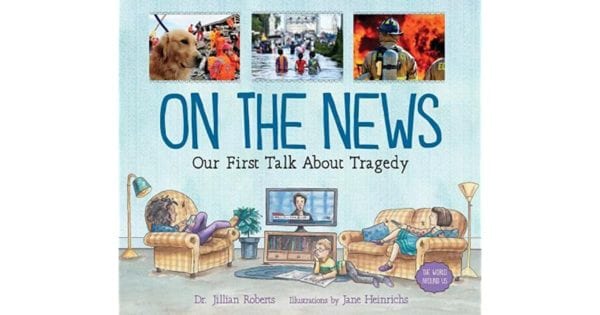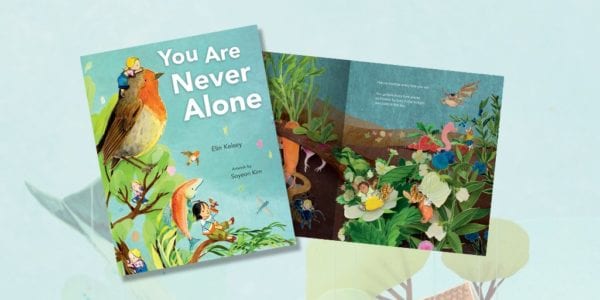
“Books are a godsend right now,” says Jillian Roberts, Victoria child psychologist and author of the World Around Us series, which introduces kids to complex issues. “They really are what’s going to preserve most people’s sanity and I think children’s sanity as well. As a parent, I would have a selection of books on hand.”
But Roberts is quick to point out that she doesn’t mean you should give your child a book and send them upstairs to read on their own. “The one thing that’s important in times of crisis is the child-parent bond,” she says. “So I encourage everybody to be reading together, in the family room, and every once in a while you stop and talk about what it is that you’re reading, catch each other up on what is happening in your story. With younger children, snuggle with them while you’re reading.”
Orca Book Publishers has made Roberts’s most relevant non-fiction resource, On the News: Our First Talk About Tragedy (illustrated by Jane Heinrichs) available as a free download to help parents of children six to eight talk through how they feel and move forward in times of crisis. “It’s very difficult for most adults to remember what it was like as a child. Just imagine from a little one’s perspective, overhearing mom and dad talking about financial worries or wondering why mom’s counting the toilet-paper rolls. The purpose of the book is to give the child an understanding and a reference, take them through an explanation of what tragedies and traumas are, but also bring the child to a place of wholeness, explaining that our communities come together, and how it gives everybody a chance to be brave and strong and helpful and compassionate to those around us.
Roberts recognizes there are a lot of books about anxiety for children out there and they could be helpful during this time. “But,” she says, “while it’s good to address anxiety, but sure to reframe, and help children understand what is a real worry and what is an imagined worry. Talk about what has happened, but explain that we shouldn’t put too much energy into thinking about things that haven’t happened yet. Shift to a place where the child has some agency and they are able to do something, like writing a letter, drawing a picture, sending a food hamper, any number of things.”
While Roberts has also written another topical book, What Happens When a Loved One Dies? Our First Talk About Death, she says it’s best to steer clear of books about loss at the moment – unless the child actually knows someone who has died of COVID-19. “We just don’t want to add to the worrying,” she says.
Whether you’re using books to unpack difficult topics or for escapism and fun, the key, says Roberts, “is making the reading experience with the child as attachment-focused as possible. Be in the same room and connected—it’s a joint experience.”
 We asked a few Canadian publishers to suggest recent titles that may help parents and children in this difficult time:
We asked a few Canadian publishers to suggest recent titles that may help parents and children in this difficult time:
You Are Never Alone, by Elin Kelsey and Soyeon Kim, ill. (Owlkids Books)
Explores how we are supported every day by nature and each other. Ages 4–12
Harry and Clare’s Amazing Staycation, by Ted Staunton and Mika Song, ill. (Penguin Random House Books)
Harry and Clare are stuck at home for their spring break – so they make their own fun. Ages 4–8
Noni Is Nervous, by Heather Hartt-Sussman and Geneviève Côté, ill. (Tundra Books)
Noni is nervous about playdates, and global warming, and most of all, about the first day of school. Ages 3–7
The Pink Umbrella, by Amelie Callot and Geneviève Godbout, ill. (Tundra Books): When it’s bright outside, cafe owner Adele is the heart of her community; but when it rains, she can’t help but stay at home inside, under the covers. Ages 6–9.
Simon Steps into the Ring, by Marylène Monette and Marion Arbona, ill.; Sophie B. Watson, trans. (Orca Book Publishers): This picture book is about a young boy who is struggling to understand and acknowledge his feelings.
Ages 6–8
Butterflies in my Belly, by Jackie MacKay and Brenda Whiteway, ill. (Acorn Press/Nimbus Publishing)
MacKay councils children through play therapy in Charlottetown, P.E.I., and her work inspired this book about a boy suffering from anxiety. Ages 6–9
Bitter and Sweet, by Sandra V. Feder and Kyrsten Brooker, ill. (Groundwood Books)
This story conveys a universal message: while life can be full of challenging moments, sweeter ones can be found and created. Ages 4–7
Scaredy Squirrel series, by Mélanie Watt (Kids Can Press)
Scaredy Squirrel only feels safe when he’s at home and this series of books tackles all of the fears kids might have – while letting them know it’s okay to feel scared. Ages 4–8
If the World Were a Village, by David J. Smith and Shelagh Armstrong, ill. (Kids Can Press)
The book promotes “world-mindedness” by imagining the world’s population – all 6.8 billion of us – as a village of just 100 people. Ages 8–12
Freaking Out: Real Life Stories About Anxiety, by Polly Wells, ed.; Peter Mitchell, ill. (Annick Press)
These 13 personal stories from teens across North America explores the spectrum of anxiety, from angst to severe disorders. Ages 12+.
Patient Zero: Solving the Mysteries of Deadly Epidemics, by Marilee Peters (Annick Press): True stories of the pioneers of epidemiology who risked their lives to find the source of deadly diseases. Ages 10–14.
Under Pressure: The Science of Stress, Tanya Lloyd Kyi and Marie-Ève Tremblay, ill. (Kids Can Press): A tool for parents, teachers, and students to learn the science behind sweaty, heart-racing, under-pressure feelings. Ages 11–14.
Don’t Stress: How to Handle Life’s Little Problems, by Helaine Becker (Scholastic)
Part of a trilogy of books about mindful activities to help you manage stressful situations. Ages 8–12
Heads Up: Changing Minds on Mental Health by Melanie Siebert (Orca Book Publishers)
A non-fiction book for teens that is a go-to guide for those who want to know about mental health, mental illness, trauma, and recovery. Ages 12+
 Contact us via email
Contact us via email
